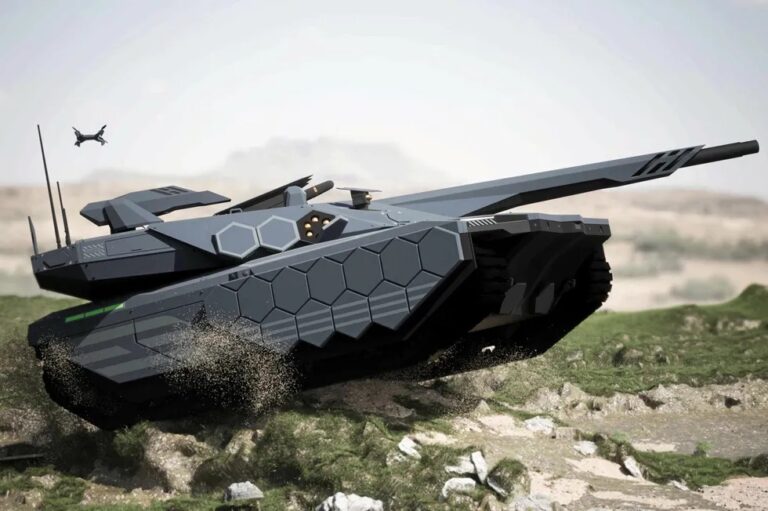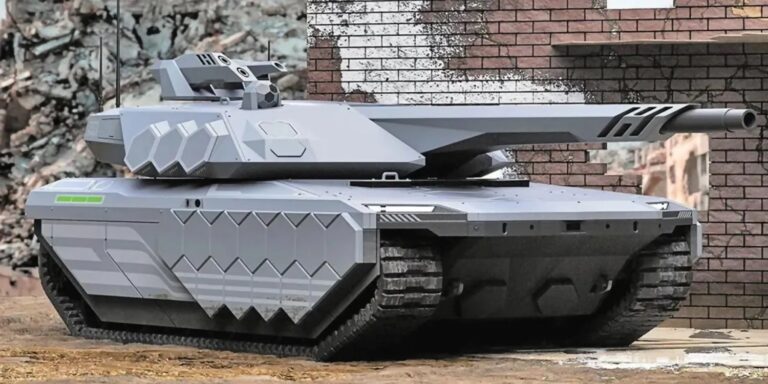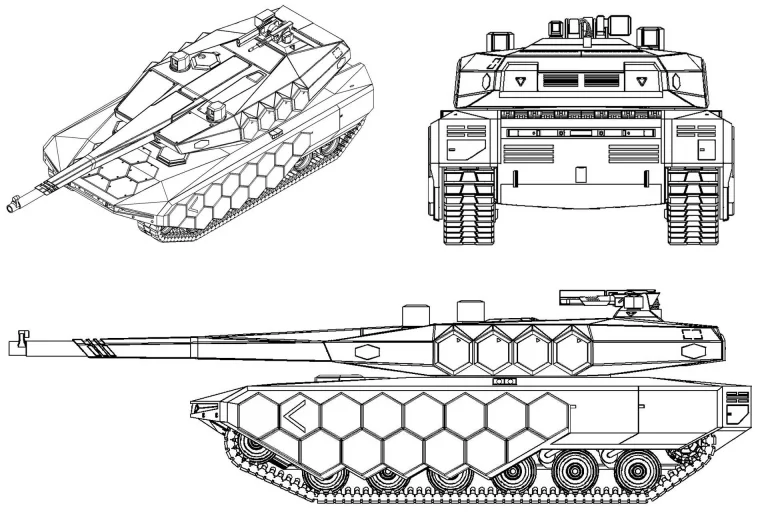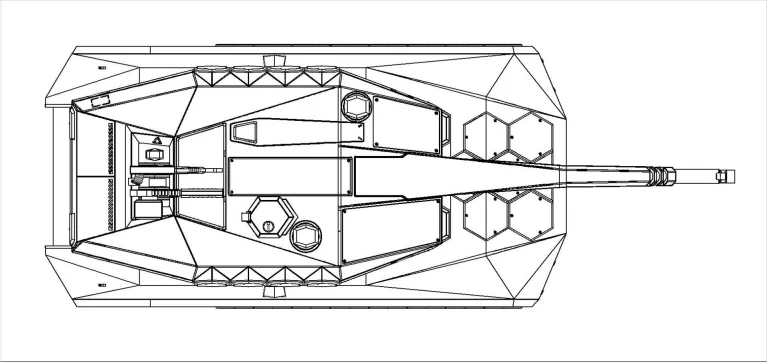On April 17, 2025, Hyundai Rotem, a prominent South Korean defense manufacturer, officially registered a new design with the South Korean Intellectual Property Office (KIPO) for a future main battle tank. The filing, submitted under application number 30-2024-0034192 on August 26, 2024, underwent examination and was approved on March 21, 2025.
The design was formally registered and published on April 21, 2025, with Hyundai Rotem paying the initial three-year registration fee of 65,000 KRW on the same day, securing protection for the design until August 26, 2044. The registered item is a single basic design for a “tracked ground combat vehicle” (classification 12), identified by serial number M001. The filing includes nine drawings illustrating the vehicle from multiple angles, such as an isometric view, orthographic projections, and enlarged views of the front and rear.

The description notes that the materials used are either metal or synthetic resin, and the design is based on a future-oriented stealth shape suitable for combat missions in field conditions. It also specifies that the configuration is intended for armored and mechanized units. Compared to the previous year’s version, the turret in this 2024 design appears slightly simplified.
The design is widely believed to be associated with the K3 Next-Generation Main Battle Tank (NG-MBT) program, which Hyundai Rotem is developing as a potential successor to the K2 Black Panther. This new tank emerges from the South Korean military’s assessment that the K2 no longer fully meets the evolving demands of modern mechanized warfare. While there is no immediate plan to replace the K1 series—still in service due to insufficient production of the K2 to retire older M48A5K tanks—the need for a next-generation tank has grown more pressing. This urgency stems from new armored warfare scenarios, particularly influenced by lessons from the Russia-Ukraine war. The K3 is intended to surpass current main battle tanks like the M1 Abrams and T-14 Armata in key capabilities while addressing the latest requirements for stealth, survivability, and mobility in future operational environments. Hyundai Rotem has progressively revealed several mockups of the tank, starting at DX Korea 2022, followed by displays at ADEX 2023 and Eurosatory 2024.
According to the latest configuration data, the NG-MBT follows a traditional layout with a front compartment, central turret, and rear engine. Its maximum combat weight is kept under 55 tons, with external dimensions not exceeding 10.8 meters in length, 3.6 meters in width, and 2.4 meters in height. A standout feature is its fully unmanned turret, paired with an armored crew capsule at the front of the hull that houses a crew of two or three—the driver, commander, and gunner. The turret sits at the rear of the chassis, while the powerpack is positioned at the front, a setup reminiscent of the Israeli Merkava, designed to enhance crew survivability. This arrangement separates the crew from the automatic loader and ammunition storage, reducing the risk to operators if the turret is penetrated or ammunition detonates. The design aligns with previously known models, featuring a low-profile, stealth-optimized hull with reduced radar and thermal signatures. A 2023 version resembled the K2 Black Panther externally but incorporated distinct elements like a CITV-integrated Remote Weapon Station (RWS), a larger unmanned turret, and provisions for a crew capsule. Another variant showcased a rear-mounted launcher for rotary-wing unmanned aerial vehicles (UAVs), a 12.7mm machine gun RWS, and an infrared countermeasure system.

The K3 will initially roll out as a hybrid, blending diesel and hydrogen components, before transitioning fully to hydrogen-only propulsion. Hyundai Rotem is pioneering a hydrogen-powered propulsion system for main battle tanks—the first of its kind—working alongside the South Korean Agency for Defense Development and the Korea Research Institute for Defense Technology Planning and Advancement. The ultimate goal, set for 2040, is a fully electric tank powered by hydrogen fuel cells, batteries, and dual electric motors. For now, a transitional hybrid version combining diesel and hydrogen systems is in development. This hydrogen fuel cell technology, already utilized in Hyundai’s NEXO and ix35 Fuel Cell SUVs and hydrogen-powered trams, generates electricity through an electrochemical reaction between hydrogen and oxygen, producing only water and heat as byproducts. In this process, hydrogen enters an anode, splitting into protons and electrons. The protons pass through an electrolyte membrane to a cathode, while the electrons create an electric current in an external circuit. At the cathode, protons, electrons, and oxygen recombine to form water.
While countries like the United States, Japan, and Germany are exploring hydrogen applications for military vehicles, South Korea’s K3 stands alone as a main battle tank project prioritizing this propulsion system. The hydrogen-electric setup operates silently and emits only water vapor, cutting down on acoustic and thermal signatures. It also extends vehicle autonomy, enabling deeper penetration into enemy territory with fewer logistical demands and less vulnerability to environmental wear. The electric system delivers instant torque and better acceleration, crucial for quick repositioning after firing. Rubber tracks under consideration further reduce vibrations and noise, enhancing stealth. Operationally, the hydrogen system supports extended missions without frequent refueling, boosts survivability in degraded or polluted terrain, and lessens the risk to fuel supply lines. The tank’s combat weight remains below 55 tons to ensure mobility across challenging landscapes like mud and rubble, with a projected road speed of 70 km/h, an off-road speed of 50 km/h, and a cruising range of up to 500 kilometers. The design includes an active suspension and a hybrid powerpack tailored to support drone integration and onboard systems’ electrical needs.

Firepower revolves around a high-pressure 130mm smoothbore gun, an upgrade from the K2’s 120mm weapon. Although Rheinmetall has developed a similar caliber gun for the KF-51 Panther, no collaboration between the companies has been confirmed. The K3 will feature an automatic loading system, though the number of ready-to-fire rounds remains undisclosed. Two autoloader options are being evaluated: a carousel type, which offers greater ammunition storage but is more vulnerable if hit, and a bustle type, which prioritizes crew safety and accommodates longer projectiles at the cost of reduced capacity. Given the K2’s use of a bustle-type system and its focus on survivability, this configuration seems more likely for the K3. The design also explores a stealth barrel sleeve and thermal masking covers. Vertical Launch Systems (VLS) at the rear of the hull are proposed alongside traditional gun-launched anti-tank guided missiles (ATGMs), potentially enabling the deployment of anti-tank or surface-to-air missiles. Hyundai Rotem has clarified that loitering munitions are not currently planned for the VLS, nor are dual-purpose missile launchers being pursued. Current mockups also feature a rooftop missile launcher, a remote-controlled weapon station with a 12.7mm machine gun, and rotary-wing UAV launch and recovery systems, along with a drone jammer and turret-mounted sensors to detect and classify threats.
The K3 will incorporate an AI-based fire control and command system, capable of assigning battlefield roles, setting targeting priorities, and coordinating with unmanned assets. AI-driven situational awareness algorithms will provide 360-degree monitoring through sensor fusion, improving threat detection and mission efficiency. A CSISR system—encompassing Command, Control, Communication, Computer, Cyber Information, Surveillance, and Reconnaissance—paired with AI algorithms, satellite communications, and secure data links, will enable unit-level coordination, networked operations, and possibly autonomous drone coordination. The design anticipates both manned and optionally unmanned variants capable of autonomous platoon-level missions. For survivability, the tank will employ a modular armor system of high-hardness steel, ceramic, and composite materials. Passive armor includes non-explosive reactive armor (NxRA), also known as non-energetic reactive armor (NERA), and removable explosive reactive armor (ERA) modules on the sides and roof to counter large-caliber kinetic and chemical energy threats. The lower hull offers mine protection meeting NATO STANAG 4569 Level 4a/4b standards, guarding against 10 kg TNT blasts under the wheel and center. Stealth technologies combine radar-absorbing coatings and metamaterial-based RF and infrared camouflage, reducing visibility across infrared, radar, and millimeter-wave spectrums.

A concept model unveiled in June 2023 showcased many of these features, appearing as a K2 derivative but with a CITV-integrated remote weapon system, a larger unmanned turret, and a new armored capsule layout. It shared visual traits with the K2PL upgrade offered to Poland. Hyundai Rotem’s collaboration with Poland was cemented at the 2022 MSPO exhibition, where the company signed a Memorandum of Understanding with Polska Grupa Zbrojeniowa (PGZ) to jointly develop the K3 MBT, wheeled armored vehicles like a localized K808, and unmanned ground platforms. This partnership builds on a broader Poland-South Korea arms agreement from the same year. The registration of the K3 NG-MBT design marks a key step in South Korea’s push to modernize its armored forces, blending advanced technology with international cooperation to meet the challenges of future warfare.